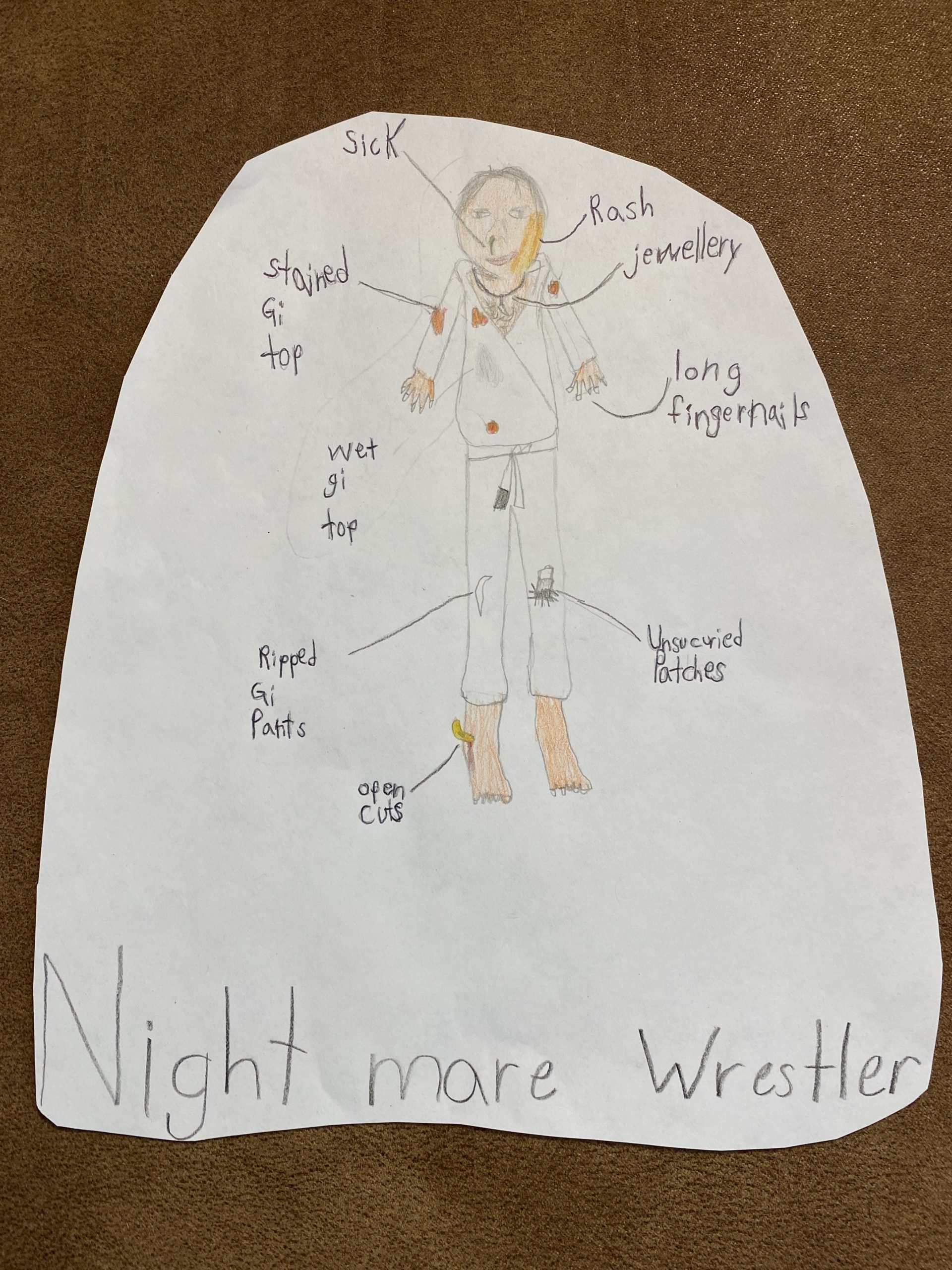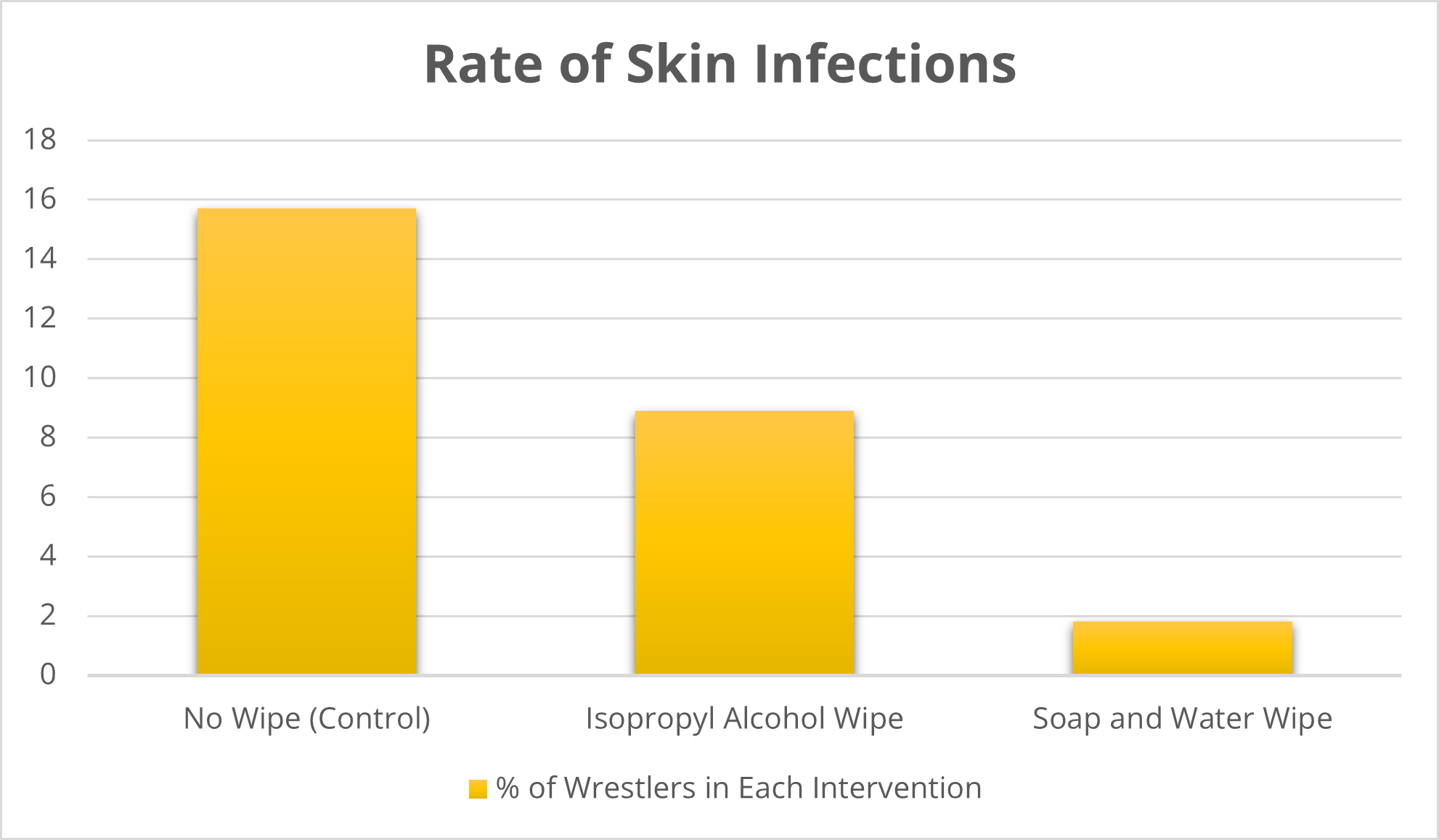Imagine walking into a gym. It’s hot, humid, and there’s a smell of mildew and foot permeating the air. There are a handful of people on the mat, one rolling with an old torn dirty gi, another pair rolling shirtless no-gi. One of them is constantly coughing and wiping his nose on his arm and on his opponent and because you’ve read the impetigo article you recognize it on another’s left ear. The mat looks more like a slip and slide due to the amount of sweat and to top it all off you notice in the corner a string mop in a bucket of some brownish tinged liquid with a couple of bubbles floating on top.
If the above scenario sounds like a Halloween jiu-jitsu special, it should. And while gyms like this are rare these days, unfortunately there are still some like it that exist. While the most reasonable and logical answer to how you can avoid getting mat funk in this setting is to not roll, for the sake of the extreme hypothetical, and a more interesting read, we’re going to review the best personal hygiene practices one can equip themselves with to give them the greatest protection possible. Now reading this article won’t make you ‘bullet-proof’ to any infectious disease encountered on the mat. The reality is infection risk still exists even if a gym is pristine and a grappler follows all of the most up to date recommendations for hygiene. However, proper hygiene measures do greatly reduce one’s risk of infection and therefore will increase the time on the mat. If you’re short on time, the following table is a summary of recommendations with their level of evidence, but for the deep dive please read on!
Figure 1 Summary of recommended interventions and their level of evidence
Continue Reading: 10min Read
Shower After Rolling
Based on the available scientific data, washing as soon as possible after rolling is the best intervention anybody can do to reduce infection risk to themselves. While the vast majority of scientific studies on gym hygiene interventions do not actually measure infection as the outcome, this is one area that went the distance and the data is the strongest.
Dr. B.J. Anderson, a fellow family doc from Minnesota who serves as a medical advisor for MN/USA wrestling (among other roles), performed this study in the 2009-2010 wrestling season. He recruited and randomized a total of 151 high school wrestlers from six different teams and followed them for two months and a total of 474 individual matches. The teams were randomized to three different interventions performed immediately after a match; one intervention was to wipe down all skin exposed areas with a soap and water wipe, the second intervention was the same but with a 70% isopropyl alcohol wipe, and the third intervention was the control in which the wrestler did no wipe down after the match. All wrestlers were allowed to shower/clean per their normal routine before and/or after matches and wrestling practices. Each team had an athletic trainer that would perform daily skin checks and if any concern for an infection arose, Dr. Anderson would examine the wrestler and make a diagnosis. What he found is summarized in Figure 2, but in short those who wiped down with soap and water right after a match had a statistically significant reduction in skin infections compared to the control while the alcohol wipes had a trend to reduced rate of infections but didn’t meet statistical significance. So washing yourself with soap and water right after you’re done rolling will absolutely reduce your risk of developing a mat funk skin infection.1
Figure 2
Use Soap, Any Soap
I’m asked very frequently about the soaps that are marketed to wrestlers and grapplers to help reduce skin infections. I’m not going to mention any specific product name as the purpose of this article is not to be an endorsement; but most in the combat sports culture have used, seen or heard about these soaps. While some include a synthetic anti-fungal medicine used for treatment of tinea gladiatorum, most all of these anti-microbial soaps contain one ingredient they claim to help reduce the risk of multiple different skin infections – tea tree oil.
While tea tree oil does have quite a bit of scientific literature showing it does indeed have anti-microbial properties, the reality is there have been ZERO studies of comparing the use of a tea tree oil soap to regular soap to see if it actually does what the manufacturers claim. It is an interesting natural compound however and while I could easily write at least a 30 page summary on tea tree oil, what it is, how it works, it’s effectiveness and safety in humans, etc, for the sake of being succinct let me sum it up in one paragraph instead.
Tea tree oil has been shown to be effective both in killing micro-organisms in the petri-dish2,12 as well as in treating athletes foot, some skin parasites, and onychomycosis.3,4,5,6 While there are no good studies on treatment of bacterial infections such as impetigo, there is evidence that it is effective in decolonizing someone known to have MRSA living on their skin but not causing an active infection.7,8 With that said, the closest any study has come to addressing whether daily use of a tea tree oil soap has any benefit has been in critically ill hospitalized patients who are known NOT to be colonized with MRSA. A randomized controlled trial (RCT) from Northern Ireland published in 2012 showed there was no difference in rates of subsequently becoming colonized with MRSA during hospitalization between patients bathed with a 5% tea tree oil soap versus Johnson’s Baby Softwash.9 However, a more recent RCT out of Egypt showed that prevention of MRSA colonization could be obtained if a tea tree oil containing body lotion was applied on all the skin after a daily tea tree oil wash compared to a usual soap and water daily bath.10 Again, whether this leads to less actual clinical infections is not known, especially in healthy non-hospitalized adults.
While toxic if ingested, for what its worth, topical use of tea tree oil is fairly safe. A small percentage of people can have either an allergic or irritant skin reaction, and this is more commonly seen with the higher concentrations of the oil.11,12,13 It should be known that tea tree oil does have the ability to stimulate estrogen receptors but topical use is not thought to cause any systemic effect;14 however there is one case report in the literature of a prepubescent boy developing breast buds (a.k.a. gynecomastia) after using a shampoo with tea tree oil and lavender oil, which resolved after stopping it.15
So, based on the available data, there’s no proof tea tree oil soap will make a significant difference in preventing skin infections. Current facts show it alone doesn’t prevent MRSA colonization and regular soap and water wipes have shown to actually prevent multiple types of skin infections on their own. So I recommend washing with soap, any soap.
Wash Your Gear
I say this with no data I could find to support my answer. Believe it or not even in the hospital setting the question of whether clothing transmits infection is technically unanswered.16 This is just one of those common sense issues and as one of our black belts at Paragon says, ‘part of being an adult.’ One more piece of advice handed down from the ages: to cut out the body odor, soak your stuff in the wash with at least one cup of white vinegar for an hour or more before actually washing, if you can. Your team will thank you and you’ll probably get more people wanting to roll with you.
Vaccinations
Given vaccines have the most thorough and rigorous studies of any intervention done in regards to preventing infection, it would be disingenuous if I didn’t mention them. When making the personal decision about vaccines it is important to know what the science has shown and continues to show. For the vast majority of people, vaccines are safe (in fact exponentially safer than getting the diseases they are protecting against) and effective at reducing the risk of both mild and serious disease from an infection both on an individual and collective group level.17,18,19,20 In regards to combat sports, one study, albeit small, even showed that an influenza vaccination policy of a college wrestling team in 2014 dropped influenza infection rate in the team from 40% prior to 2014 to 0%.21 Whether you choose to get vaccinated is up to you, but the reality is that they are safe and effective even for crud encountered on the mats.
Conclusion
Conclusion
In summary, if you have to roll with the nightmare wrestler as depicted by my daughter and you want to prevent mat funk it’s best to start early with being up to date on your vaccines, wash your gear, and as we were told as children, go take a shower. Overall, good old regular soap and water seems to have good evidence it does the trick. You can spend extra money on the tea tree oil soaps, but as the medical literature stands right now the only outcome you will guarantee yourself is to pay twice as much for your soap. That said, if it gets you to shower after rolling, then go for it.
References
- Anderson BJ. Effectiveness of body wipes as an adjunct to reducing skin infections in high school wrestlers. Clin J Sport Med. 2012 Sep;22(5):424-9. doi: 10.1097/JSM.0b013e3182592439. PMID: 22695403.
- Brady A, Loughlin R, Gilpin D, Kearney P, Tunney M. In vitro activity of tea-tree oil against clinical skin isolates of meticillin-resistant and -sensitive Staphylococcus aureus and coagulase-negative staphylococci growing planktonically and as biofilms. J Med Microbiol. 2006 Oct;55(Pt 10):1375-1380. doi: 10.1099/jmm.0.46558-0. PMID: 17005786.
- Ernst E, Huntley A. Tea tree oil: a systematic review of randomized clinical trials. Forsch Komplementarmed Klass Naturheilkd. 2000 Feb;7(1):17-20. doi: 10.1159/000057164. PMID: 10800248.
- Enshaieh S, Jooya A, Siadat AH, Iraji F. The efficacy of 5% topical tea tree oil gel in mild to moderate acne vulgaris: a randomized, double-blind placebo-controlled study. Indian J Dermatol Venereol Leprol. 2007 Jan-Feb;73(1):22-5. doi: 10.4103/0378-6323.30646. PMID: 17314442.
- Deyno S, Mtewa AG, Abebe A, Hymete A, Makonnen E, Bazira J, Alele PE. Essential oils as topical anti-infective agents: A systematic review and meta-analysis. Complement Ther Med. 2019 Dec;47:102224. doi: 10.1016/j.ctim.2019.102224. Epub 2019 Oct 24. PMID: 31780027.
- Bezabh SA, Tesfaye W, Christenson JK, Carson CF, Thomas J. Antiparasitic Activity of Tea Tree Oil (TTO) and Its Components against Medically Important Ectoparasites: A Systematic Review. Pharmaceutics. 2022 Jul 29;14(8):1587. doi: 10.3390/pharmaceutics14081587. PMID: 36015213.
- Lee, Rainbow & Leung, Polly & Wong, Thomas. (2014). A randomized controlled trial of topical tea tree preparation for MRSA colonized wounds. International Journal of Nursing Sciences. 1. 7–14. 1016/j.ijnss.2014.01.001.
- Dryden MS, Dailly S, Crouch M. A randomized, controlled trial of tea tree topical preparations versus a standard topical regimen for the clearance of MRSA colonization. J Hosp Infect. 2004 Apr;56(4):283-6. doi: 10.1016/j.jhin.2004.01.008. PMID: 15066738.
- Blackwood B, Thompson G, McMullan R, Stevenson M, Riley TV, Alderdice FA, Trinder TJ, Lavery GG, McAuley DF. Tea tree oil (5%) body wash versus standard care (Johnson’s Baby Softwash) to prevent colonization with methicillin-resistant Staphylococcus aureus in critically ill adults: a randomized controlled trial. J Antimicrob Chemother. 2013 May;68(5):1193-9. doi: 10.1093/jac/dks501. Epub 2013 Jan 7. PMID: 23297395.
- Nahla Shaaban Khalil, Asmaa Ibrahim, Rahma Mousa Abdelazeem. Effect of Body Wash with Tea Tree Oil on the Prevention of Methicillin–Resistant Staphylococcus aureusin Critically Ill Patients at a university hospital in Egypt. Iris J of Nur & Car. 1(4): 2019. MS.ID.000519.
- Hammer KA, Carson CF, Riley TV, Nielsen JB. A review of the toxicity of Melaleuca alternifolia (tea tree) oil. Food Chem Toxicol. 2006 May;44(5):616-25. doi: 10.1016/j.fct.2005.09.001. Epub 2005 Oct 21. PMID: 16243420.
- Pazyar N, Yaghoobi R, Bagherani N, Kazerouni A. A review of applications of tea tree oil in dermatology. Int J Dermatol. 2013 Jul;52(7):784-90. doi: 10.1111/j.1365-4632.2012.05654.x. Epub 2012 Sep 24. PMID: 22998411.
- Knight TE, Hausen BM. Melaleuca oil (tea tree oil) dermatitis. J Am Acad Dermatol. 1994 Mar;30(3):423-7. doi: 10.1016/s0190-9622(94)70050-8. PMID: 8113455.
- Nielsen JB. What you see may not always be what you get–bioavailability and extrapolation from in vitro tests. Toxicol In Vitro. 2008 Jun;22(4):1038-42. doi: 10.1016/j.tiv.2007.12.013. Epub 2007 Dec 31. PMID: 18255254.
- Henley DV, Lipson N, Korach KS, Bloch CA. Prepubertal gynecomastia linked to lavender and tea tree oils. N Engl J Med. 2007 Feb 1;356(5):479-85. doi: 10.1056/NEJMoa064725. PMID: 17267908.
- McQueen, R.H., Ehnes, B.L. (2022). Antimicrobial Textiles and Infection Prevention—Clothes and Inanimate Environment. In: Bearman, G., Morgan, D.J., K. Murthy, R., Hota, S. (eds) Infection Prevention. Springer, Cham. https://doi.org/10.1007/978-3-030-98427-4_13
- Orenstein WA, Ahmed R. Simply put: Vaccination saves lives. Proc Natl Acad Sci U S A. 2017 Apr 18;114(16):4031-4033. doi: 10.1073/pnas.1704507114.
- Minozzi S, Lytras T, Gianola S, Gonzalez-Lorenzo M, Castellini G, Galli C, Cereda D, Bonovas S, Pariani E, Moja L. Comparative efficacy and safety of vaccines to prevent seasonal influenza: A systematic review and network meta-analysis. EClinicalMedicine. 2022 Mar 25;46:101331. doi: 10.1016/j.eclinm.2022.101331.
- Baden LR, et al. Efficacy and Safety of the mRNA-1273 SARS-CoV-2 Vaccine. N Engl J Med. 2021 Feb 4;384(5):403-416. doi: 10.1056/NEJMoa2035389.
- Ridgway JP, Tideman S, French T, et al. Odds of Hospitalization for COVID-19 After 3 vs 2 Doses of mRNA COVID-19 Vaccine by Time Since Booster Dose. Published online September 23, 2022. doi:10.1001/jama.2022.17811
- Young LM, Motz VA, Markey ER, Young SC, Beaschler RE. Recommendations for Best Disinfectant Practices to Reduce the Spread of Infection via Wrestling Mats. J Athl Train. 2017 Feb;52(2):82-88. doi: 10.4085/1062-6050-52.1.02.
- Photo credit for Figure 3 Melaleuca alternifolia, Csubbra, CC BY-SA 3.0 <https://creativecommons.org/licenses/by-sa/3.0>, via Wikimedia Commons, accessed at https://commons.wikimedia.org/wiki/File:Tea_tree_plant.jpg.
- Other figures were created by author and his daughter who gave full consent for use.








Recent Comments